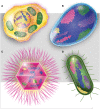The influence of rickettsiologists on post-modern microbiology
- PMID: 22919574
- PMCID: PMC3417371
- DOI: 10.3389/fcimb.2011.00008
The influence of rickettsiologists on post-modern microbiology
Abstract
Many of the definitions in microbiology are currently false. We have reviewed the great denominations of microbiology and attempted to free microorganisms from the theories of the twentieth century. The presence of compartmentation and a nucleoid in Planctomycetes clearly calls into question the accuracy of the definitions of eukaryotes and prokaryotes. Archaea are viewed as prokaryotes resembling bacteria. However, the name archaea, suggesting an archaic origin of lifestyle, is inconsistent with the lifestyle of this family. Viruses are defined as small, filterable infectious agents, but giant viruses challenge the size criteria used for the definition of a virus. Pathogenicity does not require the acquisition of virulence factors (except for toxins), and in many cases, gene loss is significantly inked to the emergence of virulence. Species classification based on 16S rRNA is useless for taxonomic purposes of human pathogens, as a 2% divergence would classify all Rickettsiae within the same species and would not identify bacteria specialized for mammal infection. The use of metagenomics helps us to understand evolution and physiology by elucidating the structure, function, and interactions of the major microbial communities, but it neglects the minority populations. Finally, Darwin's descent with modification theory, as represented by the tree of life, no longer matches our current genomic knowledge because genomics has revealed the occurrence of de novo-created genes and the mosaic structure of genomes, the Rhizome of life is therefore more appropriate.
Keywords: archaea; bacterial virulence factors; definitions; metagenomics; orphan genes; prokaryotes; tree of life; virus.
Figures





References
-
- Andersson J. O., Andersson S. G. (1999). Genome degradation is an ongoing process in Rickettsia. Mol. Biol. Evol. 16, 1178–1191 - PubMed
Publication types
MeSH terms
Substances
LinkOut - more resources
Full Text Sources

